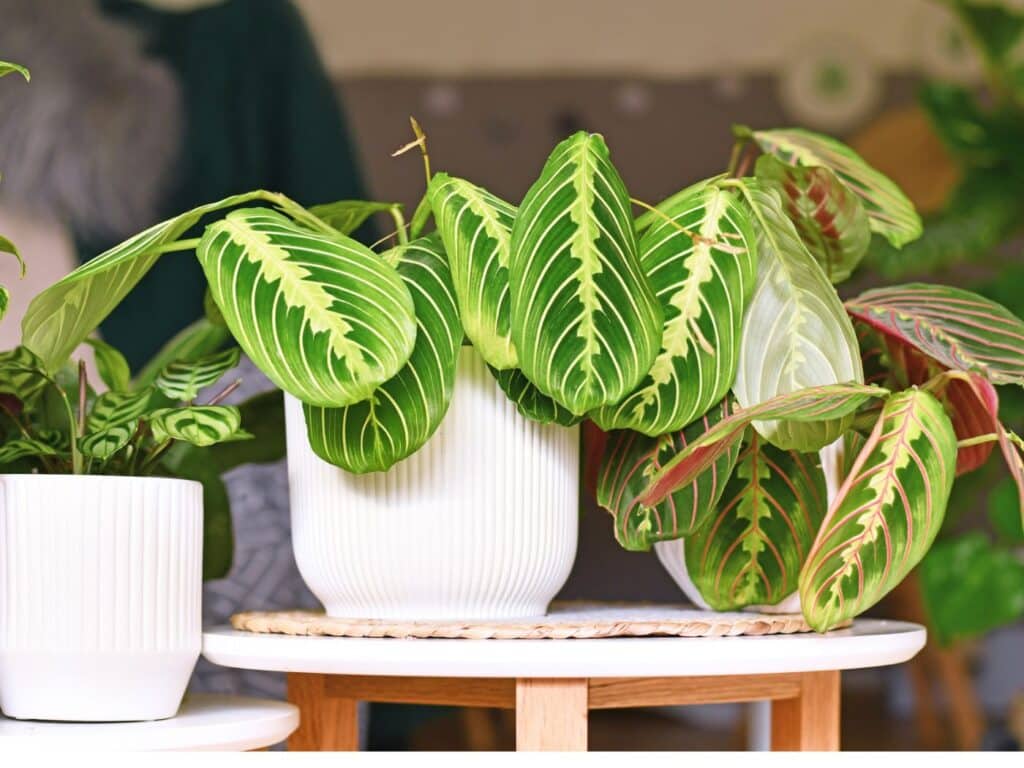Nurturing a prayer plant (Maranta leuconeura) is like unlocking a daily spectacle right in your home. Known for its unique foliage that folds up at night, as if in prayer, this plant adds not just greenery but also a touch of the dramatic to any space.
However, if you’ve ever found yourself puzzled over its care, you’re not alone. These plants have a reputation for being a bit finicky, demanding specific conditions to truly thrive.
Fear not, for mastering the art of caring for your prayer plant is well within reach. With the right guidance, you can transform your home into a lush, vibrant sanctuary that invites tranquility and beauty. Let’s dive into the essentials of prayer plant care, ensuring your green companion flourishes and continues to enchant for years to come.
Understanding the Prayer Plant (Maranta leuconeura)

Origin and Characteristics
The Prayer Plant, scientifically known as Maranta leuconeura, hails from the tropical rainforests of Brazil. This plant boasts vibrant green leaves with distinct patterns that can range from red veins to fully red leaves, depending on the variety.
Its ability to thrive in indoor conditions has made it a favorite among houseplant enthusiasts. The Prayer Plant requires indirect sunlight and enjoys humidity, mirroring its rainforest origins. Its compact size makes it perfect for shelves or small spaces, inviting a piece of the tropics into your home.
The Significance of “Prayer” Movements
The Prayer Plant gets its name from the fascinating way its leaves fold upward at night, resembling hands in prayer. This action, scientifically termed nyctinasty, serves a purpose beyond its visual appeal.
It helps the plant conserve moisture and may also deter herbivores. Observing these movements provides a unique connection to the natural world, bringing a sense of calm and wonder to your living space. The prayer movements of Maranta leuconeura epitomize the dynamic nature of plants, reminding us of the delicate balance within ecosystems.
Optimal Growing Conditions for Prayer Plants
Light Requirements
Prayer plant varieties flourish in bright, indirect sunlight. Direct exposure can cause their leaves to fade, detracting from their vibrant patterns.
Ideally, place them near a window that’s draped with sheer curtains, ensuring they receive filtered sunlight. This setup mimics their natural habitat under the canopy of tropical rainforests, providing light without the harshness.
Temperature and Humidity Preferences
Keeping your prayer plant happy involves creating a cozy, humid environment with temperatures ranging from 60-80°F (16-27°C). These plants thrive in conditions that remind them of home—namely, the warm, damp floors of Brazilian rainforests.
If your home feels like a desert, consider using a humidifier or grouping your plants together to boost the moisture in the air. Remember, sudden temperature drops or drafts are no-nos, as they can stress your plant out.
Soil and Potting Mix
Choosing the right soil mix is like picking a good wine—it needs to be just right. A well-draining, peat-based potting mix hits the mark for prayer plants, ensuring they stay moist without getting waterlogged.
Feel free to mix in some perlite or coarse sand to enhance drainage. When repotting, please do it in the spring and select a pot that’s slightly larger with enough drainage holes. No one likes soggy feet, especially not your prayer plant.
Planting and Repotting Prayer Plants

When to Plant or Repot
Spring serves as the best time to plant or repot prayer plants, right before their growth period kicks into high gear. This timing aligns with their natural cycle, allowing them to adjust and thrive in their new setting. You’ll know it’s time for a change when you see roots peeking out of the drainage holes or when growth seems to have slowed, an indicator that your plant may well be root-bound.
Tips for Successful Transplanting
Begin by selecting a pot that’s one size larger than the current one; this ensures your prayer plant has enough room to grow without being overwhelmed. Make sure the new pot has adequate drainage to avoid soggy soil conditions, which can lead to root rot.
Mixing in fresh, well-draining, peat-based soil not only refreshes the nutrients but also maintains the desired soil structure for moisture and aeration balance.
When moving your plant, be gentle to minimize stress and reduce the risk of shock. Loosening the roots gently can encourage them to spread out in their new home.
After repotting, water the prayer plant thoroughly to settle the soil around the roots and help recover from the transplant process. Stick to indirect light and keep an eye on humidity levels to keep your prayer plant happy and healthy in its new pot.
Watering and Feeding Your Prayer Plant
Watering Schedule and Techniques
For your prayer plant, balance in watering is key — not too soggy, and not too dry. Aim for consistency, watering when the top inch of the soil becomes dry. This usually translates to about once a week, but it can vary based on your home’s humidity and temperature.
Consider using tepid, filtered water to avoid shocking your plant’s roots and to keep the minerals in tap water from building up in the soil. If brown tips appear on the leaves, it may well be a call for either more water or a switch to filtered water, suggesting that your plant is quite the critic of water quality.
Fertilizing for Healthy Growth
Feeding your prayer plant contributes significantly to its vibrant appearance and vigorous growth. During the growing season (spring through fall), fertilizing every two weeks with a half-strength, balanced, liquid fertilizer provides the nutrients it craves for producing those striking leaves. However, during the winter months, it’s time to give your plant a break.
Cut back on fertilizing to allow your prayer plant to rest and prepare for the next growth spurt when spring rolls around again. Always follow the manufacturer’s instructions to avoid over-fertilization, which can lead to leaf burn — a clear sign your plant is not happy with the dinner served.
Pruning and Grooming
Trimming Dead or Yellow Leaves
Removing dead or yellowed leaves is crucial for the prayer plant’s health and aesthetic appeal. Dead leaves can invite pests and diseases, putting the entire plant at risk. Snip these leaves at their base using sterile scissors or pruning shears.
By doing this, you’re not only tidying up the plant but also redirecting energy to healthier growth. This task, performed regularly, keeps your prayer plant looking vibrant and allows for better air circulation among the leaves.
How to Encourage Full, Bushy Growth
For a fuller, bushy appearance, pinching back is your go-to method. This involves trimming the tips of the plant, especially during the growing season, to encourage branching.
Focus on the stems that are overly long or bare—the ones that seem to be reaching out into space without much foliage. By carefully pinching off the last inch of these stems, you stimulate the prayer plant to sprout two new shoots from the pinched area.
Repeat this process throughout the growing season for a denser, more attractive plant. Remember, consistency is key, and over time, you’ll notice your prayer plant becoming a lush, leafy display of greenery.
Common Issues in Prayer Plant Care
Pests and Diseases
Keeping your prayer plant healthy may well throw a few curveballs your way, primarily pests and diseases. Spider mites, mealybugs, and fungus gnats top the list of common pests that find the prayer plant irresistible.
Regularly checking the undersides of leaves can catch these unwelcome guests early. For diseases, watch out for root rot and leaf spot diseases, commonly resulting from overwatering or poor drainage. Implementing routine inspections and maintaining dry leaves are key strategies to fend off these issues.
Troubleshooting Common Problems
Prayer plants can be a bit dramatic when they’re not happy, often signaling distress through their leaves. Brown leaf tips or edges usually cry out about low humidity, while yellow leaves often suggest overwatering or poor drainage. If the leaves curl or the plant stops its characteristic praying movements, this may well be a sign of inadequate light or extreme temperatures.
Adjust your care tactics by ensuring proper moisture, adequate light, and a stable environment to help your prayer plant thrive. Remember, your plant’s appearance is its way of communicating its needs to you, so keep an eye out for these signs and act promptly to address them.
Propagating Prayer Plants
Division Method
Propagating prayer plants through division is straightforward. First, remove your plant from its pot gently to avoid damaging the roots. You’ll notice the plant naturally separates into clumps, each with its own root system.
Carefully divide these sections, ensuring each new plant has a good root structure. After division, plant each section in its own pot filled with a well-draining soil mix.
Water them lightly, and place in indirect light. This method not only gives you more plants but also rejuvenates your original prayer plant by giving its roots more space to grow.
Rooting Cuttings in Water or Soil
If you’re after simplicity, try rooting prayer plant cuttings in water. Select a healthy stem, 4-6 inches long, and cut just below a leaf node. Remove leaves near the cut end and place the stem in a jar of water.
Make sure no leaves are submerged to prevent rot. Change the water every few days to keep it fresh. In a few weeks, you’ll see roots forming. Once they’re a couple of inches long, plant them in soil, and voila, you’ve got new prayer plants.
Alternatively, you can root cuttings directly in soil for a quicker transition to a regular growing environment. Dip the cut end of your stem in rooting hormone, then plant it in a pot with moist, well-draining soil. Cover the pot with a plastic bag to create a mini greenhouse.
This maintains humidity around the cutting, encouraging root growth. Keep the soil moist but not waterlogged, and place the pot in bright, indirect light. In 4-6 weeks, your cuttings should establish roots, signaling they’re ready for regular prayer plant care.
Styling and Displaying Your Prayer Plant
Creative Potting Ideas
Choosing the right pot for your prayer plant can turn it into a statement piece in any room. Terracotta pots, with their classic look and breathable material, are excellent for encouraging air flow to the roots.
However, if you’re aiming for a more modern aesthetic, geometric patterned pots or bold colored ceramics can make your prayer plant pop. Remember, whatever pot you choose, drainage holes are non-negotiable to prevent waterlogging.
Integrating Into Home Decor
Finding the perfect spot for your prayer plant allows it to thrive and enlivens your space. With its stunning foliage, the prayer plant can elevate the look of bookshelves, desks, or side tables. Try placing it in a hanging pot for a touch of greenery from above or group it with other plants of varying heights to create a mini indoor jungle.
The key is to ensure it gets enough indirect light to keep those leaves dancing without scorching them. Your room doesn’t just get a green makeover; the air quality improves, making your home feel fresher and more inviting.
Frequently Asked Questions
What unique characteristics do prayer plants have?
Prayer plants are known for their unique “prayer” movements, where the leaves fold together at night, mimicking hands in prayer. This characteristic is linked to their circadian rhythm.
How often should I water my prayer plant?
Water prayer plants when the top inch of the soil feels dry. They prefer consistent moisture but do not like to sit in water, leading to root rot.
What is the best way to feed a prayer plant?
Feed your prayer plant with a balanced liquid fertilizer every two weeks during the growing season (spring and summer) and reduce to once a month during fall and winter.
How do I prune a prayer plant?
Prune your prayer plant by removing yellow or brown leaves at the base of the stem. This encourages healthy growth and maintains a neat appearance.
What are common pests and diseases affecting prayer plants?
Common issues include spider mites, mealybugs, and fungal diseases. Regularly check the plant and treat with insecticidal soap or neem oil for pests, and a fungicide for diseases.
Can you offer any creative potting ideas for prayer plants?
Consider using terracotta pots for better airflow or geometric patterned pots for a modern look. Ensure pots have drainage holes to prevent waterlogging.
Where is the best place to display prayer plants in my home?
Prayer plants thrive in indirect light, making them suitable for bookshelves, desks, or hanging pots. Grouping with other plants helps create a visually appealing mini indoor jungle while ensuring enough light.
How do prayer plants improve air quality at home?
Prayer plants can help improve air quality by removing toxins and increasing humidity through transpiration, making them not only decorative but also beneficial for your home environment.
Image by firn/depositphotos







